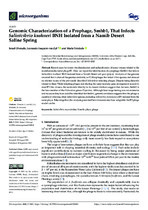| dc.contributor.author | Olonade, Israel | |
| dc.contributor.author | van Zyl, Leonardo Joaquim | |
| dc.contributor.author | Trindade, Marla | |
| dc.date.accessioned | 2021-10-08T09:13:37Z | |
| dc.date.available | 2021-10-08T09:13:37Z | |
| dc.date.issued | 2021 | |
| dc.identifier.citation | Olonade, I., van Zyl, L.J., & Trindade, M. (2021). Genomic Characterization of a Prophage, Smhb1, That Infects Salinivibrio kushneri BNH Isolated from a Namib Desert Saline Spring. Microorganisms. 9. 2043. DOI: 10.3390/microorganisms9102043. | en_US |
| dc.identifier.issn | 20762607 | |
| dc.identifier.uri | 10.3390/microorganisms9102043 | |
| dc.identifier.uri | http://hdl.handle.net/10566/6873 | |
| dc.description | Funding text 1
Funding: This work was supported by the National Research Foundation (NRF) of South Africa.
Funding text 2
This work was supported by the National Research Foundation (NRF) of South Africa. We wish to thank the researcher and management of the Gobabeb Desert research station for hosting us during sample collection. We also thank Mohammed Jaffer at the Electron Microscope Unit at the University of Cape Town for helping to capture TEM images. | en_US |
| dc.description.abstract | Recent years have seen the classification and reclassification of many viruses related to the model enterobacterial phage P2. Here, we report the identification of a prophage (Smhb1) that infects Salinivibrio kushneri BNH isolated from a Namib Desert salt pan (playa). Analysis of the genome revealed that it showed the greatest similarity to P2-like phages that infect Vibrio species and showed no relation to any of the previously described Salinivibrio-infecting phages. Despite being distantly related to these Vibrio infecting phages and sharing the same modular gene arrangement as seen in most P2-like viruses, the nucleotide identity to its closest relatives suggest that, for now, Smhb1 is the lone member of the Peduovirus genus Playavirus. Although host range testing was not extensive and no secondary host could be identified for Smhb1, genomic evidence suggests that the phage is capable of infecting other Salinivibrio species, including Salinivibrio proteolyticus DV isolated from the same playa. Taken together, the analysis presented here demonstrates how adaptable the P2 phage model can be. © 2021 by the authors. Licensee MDPI, Basel, Switzerland. | en_US |
| dc.description.sponsorship | National Research Foundation (NRF
University of Cape Town (UCT) | en_US |
| dc.language.iso | en | en_US |
| dc.publisher | MDPI | en_US |
| dc.subject | Myoviridae | en_US |
| dc.subject | Namib | en_US |
| dc.subject | Phage | en_US |
| dc.subject | Playa | en_US |
| dc.subject | Salinivibrio | en_US |
| dc.subject | Model enterobacterial phage P2 | en_US |
| dc.subject | Viruses | en_US |
| dc.subject | Vibrio species | en_US |
| dc.subject | Genome analysis | en_US |
| dc.subject | Namibia | en_US |
| dc.subject | Salt pans | en_US |
| dc.title | Genomic characterization of a prophage, Smhb1, that Infects Salinivibrio kushneri BNH isolated from a Namib Desert saline spring | en_US |
| dc.type | Article | en_US |

